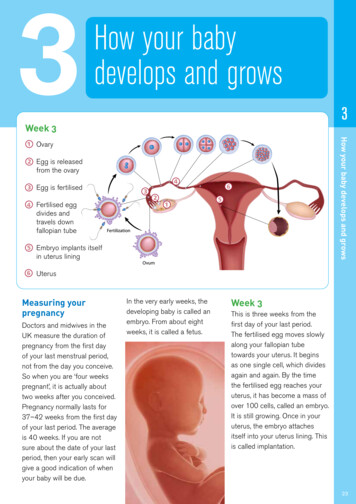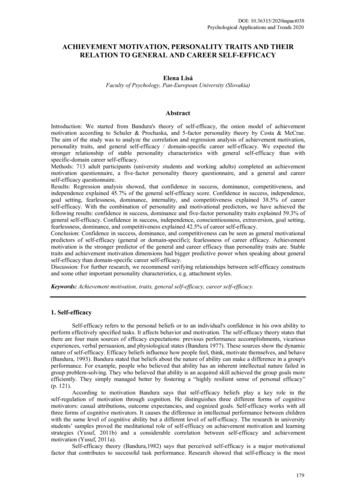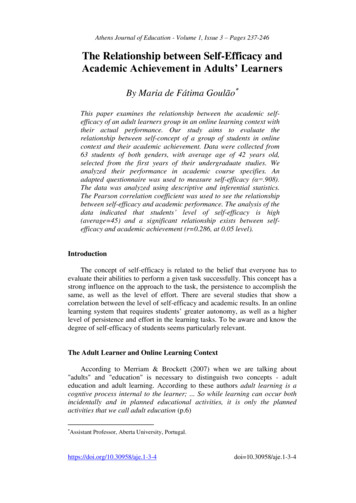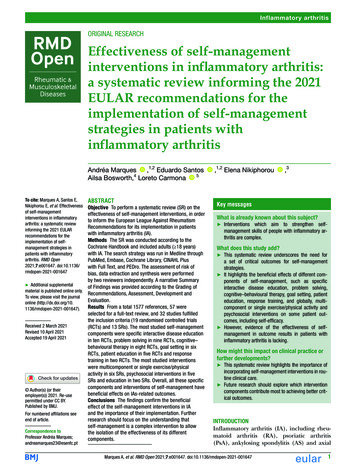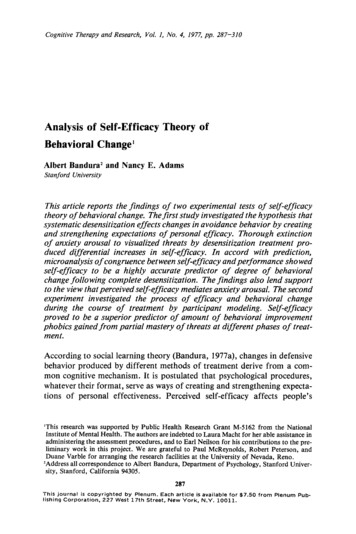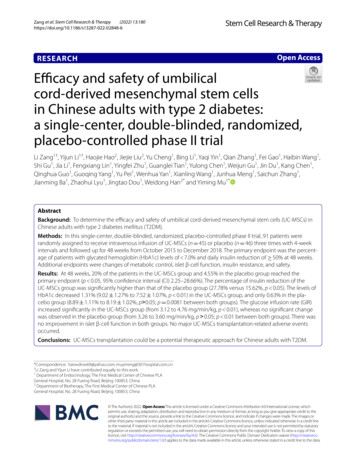
Transcription
(2022) 13:180Zang et al. Stem Cell Research & pen AccessRESEARCHEfficacy and safety of umbilicalcord‑derived mesenchymal stem cellsin Chinese adults with type 2 diabetes:a single‑center, double‑blinded, randomized,placebo‑controlled phase II trialLi Zang1†, Yijun Li1†, Haojie Hao2, Jiejie Liu2, Yu Cheng1, Bing Li1, Yaqi Yin1, Qian Zhang1, Fei Gao1, Haibin Wang1,Shi Gu1, Jia Li1, Fengxiang Lin1, Yingfei Zhu1, Guanglei Tian1, Yulong Chen1, Weijun Gu1, Jin Du1, Kang Chen1,Qinghua Guo1, Guoqing Yang1, Yu Pei1, Wenhua Yan1, Xianling Wang1, Junhua Meng1, Saichun Zhang1,Jianming Ba1, Zhaohui Lyu1, Jingtao Dou1, Weidong Han2* and Yiming Mu1*AbstractBackground: To determine the efficacy and safety of umbilical cord-derived mesenchymal stem cells (UC-MSCs) inChinese adults with type 2 diabetes mellitus (T2DM).Methods: In this single-center, double-blinded, randomized, placebo-controlled phase II trial, 91 patients wererandomly assigned to receive intravenous infusion of UC-MSCs (n 45) or placebo (n 46) three times with 4-weekintervals and followed up for 48 weeks from October 2015 to December 2018. The primary endpoint was the percentage of patients with glycated hemoglobin (HbA1c) levels of 7.0% and daily insulin reduction of 50% at 48 weeks.Additional endpoints were changes of metabolic control, islet β-cell function, insulin resistance, and safety.Results: At 48 weeks, 20% of the patients in the UC-MSCs group and 4.55% in the placebo group reached theprimary endpoint (p 0.05, 95% confidence interval (CI) 2.25–28.66%). The percentage of insulin reduction of theUC-MSCs group was significantly higher than that of the placebo group (27.78% versus 15.62%, p 0.05). The levels ofHbA1c decreased 1.31% (9.02 1.27% to 7.52 1.07%, p 0.01) in the UC-MSCs group, and only 0.63% in the placebo group (8.89 1.11% to 8.19 1.02%, p 0.05; p 0.0081 between both groups). The glucose infusion rate (GIR)increased significantly in the UC-MSCs group (from 3.12 to 4.76 mg/min/kg, p 0.01), whereas no significant changewas observed in the placebo group (from 3.26 to 3.60 mg/min/kg, p 0.05; p 0.01 between both groups). There wasno improvement in islet β-cell function in both groups. No major UC-MSCs transplantation-related adverse eventsoccurred.Conclusions: UC-MSCs transplantation could be a potential therapeutic approach for Chinese adults with T2DM.*Correspondence: hanwdrsw69@yahoo.com; muyiming@301hospital.com.cn†Li Zang and Yijun Li have contributed equally to this work.1Department of Endocrinology, The First Medical Center of Chinese PLAGeneral Hospital, No. 28 Fuxing Road, Beijing 100853, China2Department of Biotherapy, The First Medical Center of Chinese PLAGeneral Hospital, No. 28 Fuxing Road, Beijing 100853, China The Author(s) 2022. Open Access This article is licensed under a Creative Commons Attribution 4.0 International License, whichpermits use, sharing, adaptation, distribution and reproduction in any medium or format, as long as you give appropriate credit to theoriginal author(s) and the source, provide a link to the Creative Commons licence, and indicate if changes were made. The images orother third party material in this article are included in the article’s Creative Commons licence, unless indicated otherwise in a credit lineto the material. If material is not included in the article’s Creative Commons licence and your intended use is not permitted by statutoryregulation or exceeds the permitted use, you will need to obtain permission directly from the copyright holder. To view a copy of thislicence, visit http:// creat iveco mmons. org/ licen ses/ by/4. 0/. The Creative Commons Public Domain Dedication waiver (http:// creat iveco mmons. org/ publi cdoma in/ zero/1. 0/) applies to the data made available in this article, unless otherwise stated in a credit line to the data.
Zang et al. Stem Cell Research & Therapy(2022) 13:180Page 2 of 10Trial registration This study was registered on ClinicalTrials.gov (identifier: NCT02302599).Keywords: Type 2 diabetes mellitus, Umbilical cord-derived mesenchymal stem cells, Glycated hemoglobin A1c, Isletβ-cell function, Insulin resistanceBackgroundType 2 diabetes mellitus (T2DM) is a heterogeneoussyndrome that is characterized by a progressive deterioration in glycemic control caused by decreased insulinsensitivity and diminished insulin secretion, which hasbecome a serious threat to human health worldwide dueto its high prevalence and severe morbidity. Diet control,physical exercise, and glucose-lowering medications havebeen shown to temporarily improve hyperglycemia butcannot inhibit the pathogenesis or reduce the morbidityof T2DM. Therefore, the development of more effectiveapproaches for the treatment of T2DM is required.Mesenchymal stem cells (MSCs) are a type of adultstem cells with profound anti-inflammatory and immunomodulatory capacities by secreting a variety ofcytokines and immunosuppressive molecules [1, 2]. Theyhave been successfully applied in the treatment of different types of autoimmune diseases, such as stroke [3],myocardial infarction [4], rheumatoid arthritis, systemiclupus erythematosus [5, 6], and graft versus host disease[7]. Chronic inflammatory responses and immune disorders in insulin-sensitive tissues and pancreatic isletscontribute to insulin resistance, islet β-cell destruction,and the onset of T2DM. Therefore, MSCs transplantation might be a therapeutic option for T2DM. Previousanimal studies have demonstrated that MSCs treatmentameliorated hyperglycemia by promoting pancreatic isletrecovery and alleviating insulin resistance [8, 9]. Moreover, an increasing number of clinical trials have reportedthe therapeutic effects and safety of MSCs transplantation in patients with T2DM [10–20]. MSCs can bederived from various tissues (e.g., bone marrow, adiposetissues, and umbilical cord), and the procurement or useof MSCs is deemed non-controversial. MSCs were firstisolated from bone marrow [21], which was consideredthe most accessible source of MSCs for the treatmentof T2DM [22]. Several clinical trials have confirmed thetherapeutic potential of bone marrow-derived MSCs(BM-MSCs) in T2DM [10, 12, 14–17]. Umbilical cordderived MSCs (UC-MSCs) share similar immunosuppressive properties as BM-MSCs and possess clinicalpotential for T2DM owing to their low-cost, pain-free,high-yield, rapid-collection, and non-immunogenicitycharacteristics [19]. However, few clinical studies havefocused on the treatment of T2DM with UC-MSCs andno clinical trials have reported the effect of UC-MSCs oninsulin resistance in patients with T2DM. Therefore, asingle-center, randomized, double-blinded, placebo-controlled phase II trial was performed to explore the efficacy and safety of intravenous infusion of UC-MSCs inpatients with T2DM.MethodsStudy design and participantsThis prospective, single-center, randomized, doubleblinded, placebo-controlled phase II trial was performedat the First Medical Center of Chinese PLA GeneralHospital (PLAGH; Beijing, China) from October 2015to December 2018. The study protocol was approvedby the Ethical Committee of the First Medical Center ofPLAGH (Approval No. 2013-107-01) and conformed tothe Declaration of Helsinki guidelines. All participantsprovided written informed consent before recruitment.This study was registered on ClinicalTrials.gov (identifier: NCT02302599).Patients who met the following inclusion criteriawere qualified for enrollment: (1) aged between 20 and65 years; (2) diagnosed with T2DM for 20 years (HbA1clevels between 7.0% and 12.0%, inclusive; (3) inadequatelycontrolled by stable insulin therapy (0.5–1.0 U/kg/day)with metformin for 3 months; (4) with fasting C-peptide levels of 1 ng/mL; and (5) with a body mass index(BMI) of 24–40 kg/m2. Patients were excluded from thisstudy if they had ketonuria, tumors, serum creatininelevels 175 μmol/L, previously diagnosed with myocardial infarction, current angina or heart failure, 1 majorvascular event, retinopathy that required laser treatment,malignant hypertension, an uncorrected endocrine disorder, occupations that precluded insulin therapy, severeconcurrent illness that limited life expectancy, inadequate understanding of the study protocol, drug abuse,planning pregnancy, and an allergic constitution. The fulllist of inclusion and exclusion criteria is provided in theappendix.Randomization and maskingThe Interactive Web Response System was used to assigneligible patients into the trial in a 1:1 ratio according toage of the patients ( 40 or 40 years), BMI ( 28, 28,or 32 kg/m2), duration of T2DM ( 5, 5, or 10 years),and HbA1c levels ( 7.5%, 7.5% or 9%). All patientswere assessed at baseline and pre-established follow-uptime points (at 9, 20, 32, and 48 weeks). All investigatorsand participants were masked to treatment allocation.
Zang et al. Stem Cell Research & Therapy(2022) 13:180Page 3 of 10ProceduresEndpointsHuman umbilical cords were obtained from healthywomen who gave birth in the First Medical Center ofChinese PLAGH. All subjects provided informed consent. All procedures were performed according to theGuidelines of the Ethics Committee of the First Medical Center of Chinese PLAGH. UC-MSCs were isolatedfrom the gelatinous tissues surrounding the vein andartery and were characterized by phenotype analysis andcell differentiation assay as previously described [23, 24].Patients who met the eligibility criteria were randomlyassigned to receive intravenous infusion of UC-MSCs(100 mL) or the same volume and appearance of placebo(UC-MSCs suspension liquid composed of saline with 3%human albumin and 0.5 mL multivitamins) at the elbowjoint three times with an interval of 4 weeks and thendischarged after 24 h of observation without any adverseevents. UC-MSCs at four passages were used in thisstudy, and the total number of UC-MSCs for each transfusion was 1 106/kg.After discharge, patients were followed every 12 weeksfor 48 weeks and required to perform self-monitoringof blood glucose ( 15 times per week that included a5-point profile) on different days during follow-up. Insulin titration was based on peripheral blood glucose levels,with target fasting plasma glucose levels between 4.4 and7.0 mmol/L. Patients were recommended to maintain aregular diabetic diet and healthy lifestyle during hospitalization and follow-up. If the total daily insulin dose of apatient was 0.2 U/kg at any time during the study, theydiscontinued the use of exogenous insulin and were givenan oral anti-diabetic agent to prevent hypoglycemia. Ifa patient developed uncontrolled blood glucose with atotal daily insulin dose of 1.5 U/kg, they discontinuedthe study, and the hypoglycemic strategy was adjustedaccording to the condition of the patient to prevent diabetic complications. Insulin requirement and HbA1c levels were assessed every 12 weeks. Islet β-cell function wasindicated by the levels of fasting C-peptide, fold changein C-peptide levels stimulated by intravenous administration of 1 mg glucagon, and the C-peptide area underthe curve (AUCC-pep) in the oral glucose tolerance test(OGTT, 6 points) at baseline and 9, 20, and 48 weeks. TheAUCC-pep was calculated using the trapezoidal method.The glucose infusion rate (GIR) measured by a hyperinsulinemic-euglycemic clamp (HEC) was used to indicateinsulin resistance at baseline, 9 and 48 weeks. The potential risk of UC-MSCs transplantation was observed during treatment and follow-up.The primary endpoint was the percentage of patientswith HbA1c levels of 7.0% and daily insulin reduction of 50% from baseline to 48 weeks. The secondaryendpoints were changes in insulin requirement, HbA1clevels, and percentage of patients with HbA1c levelsof 7.0% from baseline to 9, 20, 32, and 48 weeks; changesin islet β-cell function (indicated by fasting C-peptide levels, glucagon-stimulated C-peptide changes, and AUCCpep) from baseline to 9, 20, and 48 weeks; and changes ofinsulin resistance (indicated by GIR) from baseline to 9and 48 weeks.The primary safety endpoints included immediateadverse events following intravenous administration ofUC-MSCs or placebo, adverse events related to hypersensitivity, injection site reactions, infection, tumorformation, abnormal vital signs in electrocardiogram,ultrasound scan, and laboratory tests, and occurrence ofhypoglycemia in the safety population (defined as all participants who received 1 dose of UC-MSCs or placebo).More details and the review process are provided in theappendix.Statistical analysisData were analyzed using the SAS software (version9.4). Normally distributed continuous variables werepresented as mean standard deviation (SD), whilenon-normally distributed variables were expressed asmedian (IQR). An independent two-sample t-test wasused to determine the differences of quantitative variables (e.g., fasting plasma glucose levels, HbA1c levels,fasting C-peptide levels, insulin dose, and GIR) betweenboth groups. Non-normally distributed variables wereanalyzed using the Wilcoxon rank-sum test. Categorical variables were expressed as frequency and percentile.A Chi-squared (χ2) test or Fisher’s exact test was usedto determine statistical significances between the twogroups. The paired t-test or Wilcoxon matched-pairssigned-rank test was used for within-group comparisons. The χ2 test was performed to analyze the differences in the percentage of patients with HbA1c levelsof 7.0% and daily insulin reduction of 50% betweenboth groups. The 95% confidence interval (CI) of the ratedifference was also determined. A p-value 0.05 was considered statistically significant.ResultsCharacterization of human UC‑MSCsCultured human UC-MSCs had a bipolar spindleshaped and fibroblast-like morphology (Additional file 1:Fig. S1A). Then, the immunophenotypic features andmulti-lineage differentiation potential of adherent cellswere examined. As shown in Additional file 1: Fig. 1B,
Zang et al. Stem Cell Research & Therapy(2022) 13:180cells expressed surface markers of UC-MSCs, includingCD90, CD73, and CD105, and negative surface markersof UC-MSCs, including CD34, CD45, and HLA-DR, werenot detected. Moreover, UC-MSCs exhibited differentiation potential to osteoblasts (Additional file 1: Fig. S1C)and adipocytes (Additional file 1: Fig. S1D).Page 4 of 10Study populationBetween October 2015 and December 2018, 183patients were screened for eligibility and 91 were finallyrecruited. Enrolled subjects were randomly assigned toreceive UC-MSCs transplantation (n 45) or placebo(n 46). A total of 73 (86.8%) patients completed thetrial, with 37 (82.2%) patients in the UC-MSCs groupand 36 (78.3%) patients in the placebo group. Twopatients in the placebo group did not complete all treatments. Two patients were withdrawn due to adverseFig. 1 Flowchart of the study. UC-MSCs, umbilical cord mesenchymal stem cellsTable 1 Baseline characteristics of patientsCharacteristicsUC-MSCS (N 45)Placebo (N 46)p-valueAge (years)50.00 9.3850.45 8.030.806830 (68.18%)0.555228.69 3.3528.13 3.040.415857.36 18.9056.41 12.540.78198.58 1.930.77371.93 0.650.5905Gender (male) (n (%))BMI (kg/m2)Duration of diabetes (years)Insulin requirement (U/day)Insulin requirement (U/kg/day)Fasting plasma glucose (mmol/L)Glycated hemoglobin A1c (%)Fasting C-peptide (ng/mL)GIR (mg/min/kg)28 (62.22%)11.44 4.780.72 0.208.71 2.169.02 1.272.01 0.703.12 1.46Data are shown as mean SD or n (%). GIR, Glucose infusion rate11.70 3.960.78080.71 0.150.69928.89 1.110.61733.26 1.160.6177
Zang et al. Stem Cell Research & Therapy(2022) 13:180events, and six patients were lost to follow-up in bothgroups (Fig. 1). The demographic and clinical characteristics of patients at baseline were balanced betweenthe two groups (Table 1).EfficacyCompared with the placebo group, more patients in theUC-MSCs group achieved the primary endpoint. At48 weeks following treatment, 20% of the patients in theUC-MSCs group achieved the goal of HbA1c 7.0% anddaily insulin reduction 50%, compared with 4.55% inthe placebo group (p 0.05, Table 2). The 95% CI for ratedifference between both groups was 2.25–28.66%.In both groups, the daily insulin requirement at 9,20, 32, and 48 weeks progressively decreased compared with their respective baseline values (p 0.01versus baseline for both groups). However, insulin requirement of patients in the UC-MSCs groupwas still lower than that of the placebo group at 9,Page 5 of 1020, 32, and 48 weeks (0.50 0.18 versus 0.63 0.19U/kg/day, p 0.01; 0.50 0.24 versus 0.58 0.24 U/kg/day, p 0.05; 0.49 0.24 versus 0.59 0.27 U/kg/day, p 0.05; 0.45 0.25 versus 0.57 0.26 U/kg/day,p 0.05, respectively) (Fig. 2A). Similar patterns wereobserved in total insulin dose of the two groups at thesame time points (38.80 15.89 versus 49.75 14.92U/day, p 0.01; 37.81 19.87 versus 45.56 19.14 U/day, p 0.05; 37.32 19.63 versus 46.19 21.85 U/day, p 0.05; 34.51 20.19 versus 45.19 21.21 U/day,p 0.05, respectively) (Fig. 2B). The percentage of insulin reduction in the UC-MSCs group was significantlyhigher than that of the placebo group at 9, 20, 32, and48 weeks (30.00% versus 12.77%, p 0.01; 27.83% versus 15.25%, p 0.01; 24.44% versus 10.24%, p 0.05,27.78% versus 15.62%, p 0.05, respectively) (Fig. 2C).Overall, 13.5% (5/37) patients became insulin-free at8–24 weeks (12 7.6 weeks) after UC-MSCs transplantation and remained insulin-free without re-useTable 2 The percentage of patients with HbA1c levels of 7.0% and daily insulin reduction of 50% at 9–48 weeks of follow-upUC-MSCS (% of patients)PLACEBO (% of patients)p-value9 weeks8.892.270.360720 weeks15.569.090.354232 weeks15.569.090.354248 weeks20.004.550.0268Fig. 2 Insulin requirement and HbA1c levels after treatment with UC-MSCs or placebo. *p 0.05, **p 0.01, ***p 0.001 between both groups.HbA1c, glycated hemoglobin A1c
Zang et al. Stem Cell Research & Therapy(2022) 13:180for 37.2 15.2 weeks. No patient in the placebo groupbecame insulin-free.The HbA1c levels declined after UC-MSCs transplantation with a maximum decrease observed at 9 weeksafter treatment, and slightly increased at 20, 32, and48 weeks of follow-up; however, they were still lowerthan the values at baseline (9.02 1.27%, 7.20 0.92%,7.34 1.04%, 7.49 1.07%, and 7.52 1.07% at baseline and 9, 20, 32, and 48 weeks, respectively; p 0.01compared with baseline). In addition, the HbA1c levels of the placebo group underwent a slight decreaseat 9 weeks and then gradually increased to relativelyhigh levels (8.89 1.11%, 7.83 1.18%, 7.96 1.21%,8.00 1.18%, and 8.19 1.02% at baseline and 9, 20,32, and 48 weeks, respectively; p 0.01 compared withbaseline). The HbA1c levels in the UC-MSCs groupwere lower than those of the placebo group at thesame time points during follow-up (p 0.01 at 9 and48 weeks, p 0.05 at 20 weeks, p 0.05 at 32 weeksbetween both groups) (Fig. 2D). The HbA1c levelsdecreased 1.31% in the UC-MSCs group but only 0.63%in the control group at 48 weeks (p 0.0081). More participants in the UC-MSCs achieved the target HbA1clevels ( 7.0%), compared with the placebo group at 9,20, 32, and 48 weeks (55.56% versus 29.55%, p 0.05;40.00% versus 25.00%, p 0.05; 42.22% versus 22.73%,Page 6 of 10p 0.05; and 40.00% versus 9.09%, p 0.01, respectively) (Fig. 2E). These results suggested the therapeuticpotential of UC-MSCs transplantation in T2DM.The fasting C-peptide levels in the UC-MSCs groupdid not significantly change after treatment (2.01 0.70,2.12 0.73, 2.10 0.61, and 2.07 0.70 ng/mL at baseline and 9, 20, and 48 weeks, respectively; p 0.05 compared with baseline), but decreased in the placebo group(1.93 0.65, 1.93 0.68, 1.88 0.59, and 1.86 0.60 ng/mL at baseline and 9, 20, and 48 weeks, respectively;p 0.05) (p 0.05 between both groups) (Fig. 3A). Theglucagon-stimulated fold change in C-peptide levels inthe UC-MSCs group increased at 9 weeks and progressively decreased at 20 and 48 weeks (1.94 0.61 ng/mL,2.22 0.63 ng/mL, 1.91 0.53 ng/mL, 1.92 0.53 ng/mLat baseline and 9, 20, and 48 weeks, respectively; p 0.01at 9 weeks, p 0.05 at 20 and 48 weeks compared withbaseline). The fold change in C-peptide levels graduallydecreased in the placebo group (1.85 0.28, 1.78 0.30,1.81 0.38, and 1.8 1 0.29 ng/mL at baseline and 9, 20,and 48 weeks, respectively) (p 0.05 at 9 weeks, p 0.05at 20 and 48 weeks between both groups) (Fig. 3B). TheAUCC-pep in the UC-MSCs group increased at 9 and20 weeks and slightly decreased at 48 weeks (15.03 4.9,16.80 5.29, 16.84 3.97, and 16.23 5.14 ng/h/mL at baseline and 9, 20, and 48 weeks, respectively;Fig. 3 Islet β-cell function and insulin resistance after treatment with UC-MSCs or placebo. *p 0.05, **p 0.01, ***p 0.001 between both groups;#p 0.05; ## p 0.01; ###p 0.001 versus baseline values. GIR, glucose infusion rate
Zang et al. Stem Cell Research & Therapy(2022) 13:180Page 7 of 10p 0.01 at 9 and 20 weeks, p 0.05 at 48 weeks compared with baseline), and in the placebo group graduallydecreased (15.10 3.30, 15.31 3.63, 14.79 4.27, and14.79 3.67 ng/h/mL at baseline and 9, 20, and 48 weeks,respectively, p 0.05) (p 0.05 at 20 weeks between bothgroups) (Fig. 3C). These results indicated that UC-MSCsdid not significantly improve islet β-cell function inpatients with T2DM.The HEC results showed that UC-MSCs transplantation effectively reduced insulin resistance in patients withT2DM. The GIRs of the placebo group were 3.26, 3.26,and 3.60 mg/min/kg at baseline and 9 and 48 weeks,respectively (p 0.05 compared with baseline), and thoseof the UC-MSCs group were 3.12, 3.97, and 4.76 mg/min/kg, respectively (p 0.01 at 9 and 48 weeks comparedwith baseline) (p 0.05 at 9 weeks, p 0.01 at 48 weeksbetween both groups) (Fig. 3D).SafetyAll adverse events are summarized in Table 3. Twopatients in the UC-MSCs group were withdrawn fromthe trial. One female patient had a history of hypertension and hyperlipidemia for 10 years and suffered fromcerebral infarction one month after the third UC-MSCsinfusion. She recovered two months after the treatment.One male patient suffered from femoral neck fracturecaused by an accident 3 months after the third UC-MSCsinfusion. After discussion with an independent adjudication committee, these events were not considered to berelated to UC-MSCs treatment.In the placebo group, one patient with positive insulin autoantibody (IAA) and one patient with hyperplastic anemia were withdrawn from the trial. One patientwas diagnosed with papillary thyroid carcinoma andone patient was diagnosed with prostate cancer on thefinal visit; therefore, they discontinued the study. Notreatment-associated deaths were reported during thestudy. Other patients showed no positive tumor markers, and no tumor was detected by imaging examinations.Physical examinations and laboratory tests revealed noother UC-MSCs-related side effects within 48 weeks offollow-up. All patients (n 91) remain under follow-upfor potential late-onset side effects.DiscussionThis prospective, single-center, randomized, doubleblinded, placebo-controlled phase II trial showed thatintravenous infusion of UC-MSCs at the elbow jointresulted in a higher percentage of patients achieving thetarget HbA1c levels 7.0% and daily insulin reductionof 50% at 48 weeks compared with the placebo group.UC-MSCs treatment reduced daily insulin requirement,decreased HbA1c levels, and ameliorated insulin resistance in a time-dependent manner. No major UC-MSCstransplantation-related adverse events occurred. Theseresults indicated the potential efficacy and safety of UCMSCs transplantation for the treatment of T2DM.In 2009, Bhansali et al. first showed that BM-MSCstransplantation significantly reduced insulin requirement and improved stimulated C-peptide levels in 10patients with T2DM [10]. Then, a number of studies haveconfirmed the efficacy and safety of BM-MSCs and placenta-derived MSCs in the treatment of T2DM [11–17],including three prospective, randomized, single-blindedplacebo-controlled studies [14, 15, 17]. UC-MSCs areimmune-privileged, immune-suppressive cells that arereadily available with few ethical issues [25]. Therefore,they might be a novel source of cell therapy for diabetes. Three studies used UC-MSCs transplantation for thetreatment of T2DM in humans. One study showed thatcombined intravenous and intrapancreatic endovascularinjection of UC-MSCs with a 5 day interval decreasedHbA1c levels and insulin dose in patients with T2DMat 6 months post-treatment (41% of the patients becameinsulin-independent; 29% of the patients showed reducedinsulin requirement by 50%). However, these indices deteriorated in the following 3–6 months [18]. Inanother study, 18 patients with T2DM received intravenous transfusion of UC-MSCs three times with 2-weekintervals for 6 months. The results showed that 8 out of18 patients were responsive to the treatment, manifestedby reduced fasting and postprandial blood glucose levels;Table 3 Summary of adverse eventsTreatment emergent adverse eventsUC-MSCS (N 45)Placebo (N 46)Cerebral infarction1 (2.22%)0Femoral neck fracture caused by accident1 (2.22%)0Positive IAA01 (2.27%)Hyperplastic anemia01 (2.27%)Papillary thyroid carcinoma01 (2.27%)Prostate cancer01 (2.27%)
Zang et al. Stem Cell Research & Therapy(2022) 13:180however, no significant difference was observed in insulin dose before and after treatment [19]. In another trial,six patients with T2DM were treated with intravenoustransfusion of UC-MSCs two times with 2-week intervalsand followed for 24 months. Three out of six patientsbecame insulin-free between 25 and 43 months. Theremaining patients continued to require insulin injections, although with a reduced dose [20]. These studiespreliminarily confirmed the efficacy of UC-MSCs forthe treatment of T2DM. However, the results of insulinrequirement following treatment were not consistent.In this double-blinded, randomized, placebo-controlledstudy, more patients in the UC-MSCs group achievedthe primary endpoint at 48 weeks following treatmentcompared with the placebo group, and insulin requirement decreased following UC-MSCs treatment in atime-dependent manner, which suggested the efficacy ofUC-MSCs treatment for T2DM. However, the percentageof insulin reduction and the proportion of patients withinsulin-free in our UC-MSCs group was lower than thosereported in other studies, which might be explained bythe heterogeneity of enrolled subjects.Previous studies showed that the HbA1c levels ofpatients with T2DM progressively declined by 1.2% afterUC-MSCs transplantation, with a maximum decreaseobserved at 3 and 6 months following treatment, andslightly increased at 12-month [18]. In the present study,the HbA1c levels of the UC-MSCs group decreased1.31% and the percentage of patients achieved the targetHbA1c levels ( 7%) was the highest (55.56%) at 9 weeksand was maintained at approximately 40% during followup. The trend of HbA1c changes in our UC-MSCs groupwas similar to that published in other studies using UCMSCs transplantation for patients with T2DM. In addition, our UC-MSCs infusion achieved a similar reductionin HbA1c levels compared with other common hypoglycemic agents to treat T2DM, which confirmed the highefficacy of UC-MSCs for the treatment of T2DM.Animal studies showed that MSCs transplantationincreased the levels of insulin and C-peptide in type 1diabetes mellitus and T2DM by promoting the replication of residual β-cells, improving the autophagy function of islets, promoting the phenotypic dedifferentiationof islet β-cells and the polarization repair of macrophagesin the local microenvironment of islets [26, 27]. In addition, some clinical studies have explored the effects ofUC-MSCs on islet β-cell function of patients with T2DM.They found that fasting serum C-peptide levels progressively increased to the peak value at 6 months followingUC-MSCs transplantation and then slightly decreased at12 months, while no significant difference was observedin OGTT 2 h postprandial C-peptide levels at baselineand 12-month post-treatment [18]. Likewise, anotherPage 8 of 10study found no significant changes in plasma C-peptidelevels at four time points (OGTT 0, 1, 2, and 3 h) afterUC-MSCs infusion [19]. Consistently, no significantimprovement in fasting plasma C-peptide levels in theUC-MSCs group was observed. Glucagon-stimulatedC-peptide levels and AUCC-pep temporarily increasedand then gradually decreased to the baseline levels afterUC-MSCs infusion. Animal studies revealed that β-celldedifferentiation rather than apoptosis was the predominant contributor to T2DM. UC-MSCs therapy wasa promising strategy for reversing β-cell dedifferentiation in T2DM. Because the reversal effect of UC-MSCswas more robust at the early stages of β-cell differentiation [28], the improvement in islet β-cell function wasnot obvious in the patients that had the disease for a longtime.MSCs infusion has been shown to reduce insulinresistance in animal T2DM models. BM-MSCs infusion ameliorated insulin resistance of rats with T2DMby activating the insulin receptor substrate 1/proteinkinase B signaling pathways [9]. UC-MSCs reduced insulin resistance in type 2 diabetic rats by eliciting adiposetissue macrophages into an anti-inflammatory phenotype [29]. In addition, adipose-derived MSCs improvedhyperglycemia in type 2 diabetic rats by regulatinghepatic glucose metabolism [30]. It has been reportedthat UC-MSCs improved insulin resistance in the liverand adipose tissues of rats with T2DM by suppressingNLRP3 inflammasome-mediated inflammation [31]. Fewclinical studies have focused on the effect of UC-MSCson insulin resistance in T2DM. In the present study, wedemonstrated that UC-MSCs infusion significantly allev
Results: At 48 weeks, 20% of the patients in the UC-MSCs group and 4.55% in the placebo group reached the primary endpoint (p 0.05, 95% condence interval (CI) 2.25-28.66%). The percentage of insulin reduction of the UC-MSCs group was signicantly higher than that of the placebo group (27.78% versus 15.62%, p 0.05). The levels of
